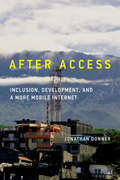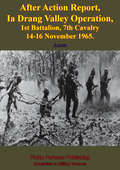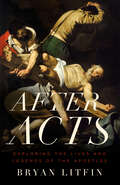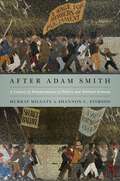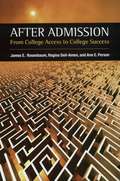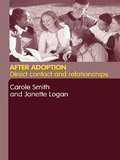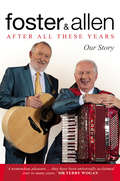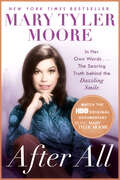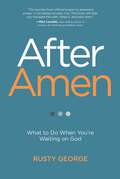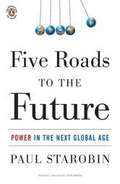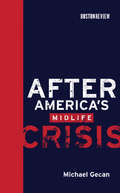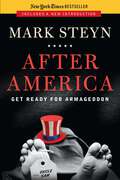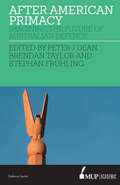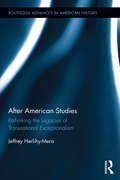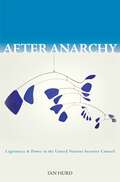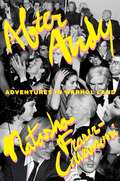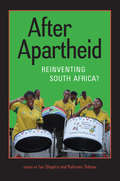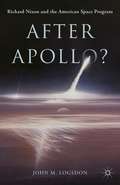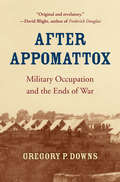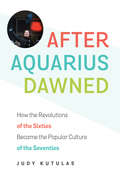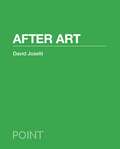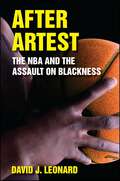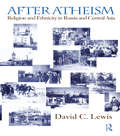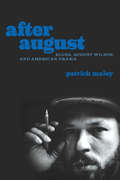- Table View
- List View
After Access: Inclusion, Development, and a More Mobile Internet (The Information Society Series)
by Jonathan DonnerAn expert considers the effects of a more mobile Internet on socioeconomic development and digital inclusion, examining both potentialities and constraints.Almost anyone with a $40 mobile phone and a nearby cell tower can get online with an ease unimaginable just twenty years ago. An optimistic narrative has proclaimed the mobile phone as the device that will finally close the digital divide. Yet access and effective use are not the same thing, and the digital world does not run on mobile handsets alone. In After Access, Jonathan Donner examines the implications of the shift to a more mobile, more available Internet for the global South, particularly as it relates to efforts to promote socioeconomic development and broad-based inclusion in the global information society.Drawing on his own research in South Africa and India, as well as the burgeoning literature from the ICT4D (Internet and Communication Technologies for Development) and mobile communication communities, Donner introduces the “After Access Lens,” a conceptual framework for understanding effective use of the Internet by those whose “digital repertoires” contain exclusively mobile devices. Donner argues that both the potentialities and constraints of the shift to a more mobile Internet are important considerations for scholars and practitioners interested in Internet use in the global South.
After Action Report, Ia Drang Valley Operation, 1st Battalion, 7th Cavalry 14-16 November 1965
by Anon."The Battle of Ia Drang was the first major battle between regulars of the United States Army and regulars of the People's Army of Vietnam (PAVN / NVA) of North Vietnam during the Vietnam War. The two-part battle took place between November 14 and November 18, 1965, at two landing zones (LZs) northwest of Plei Me in the Central Highlands of South Vietnam (approximately 35 miles south-west of Pleiku) as part of the U.S. airmobile offensive codenamed Operation Silver Bayonet. The battle derives its name from the Drang River which runs through the valley northwest of Plei Me, in which the engagement took place. Ia means "river" in the local Montagnard language.Representing the American forces were elements of the 3rd Brigade, 1st Cavalry Division: the 1st Battalion and 2nd Battalion of the 7th Cavalry Regiment, and the 2nd Battalion, 5th Cavalry Regiment of the United States Army, facing elements of the B3 Front of the PAVN (including the 304 Division) and Viet Cong. The battle involved close air support by U.S. aircraft and a strategic bombing strike by the B-52s. The initial Vietnamese assault against the landing 1st Battalion, 7th Cavalry at LZ X-Ray was repulsed after two days and nights of heavy fighting on November 14-16. However, the follow-up surprise attack on November 17 that overran the marching column of 7th Cavalry 2nd Battalion near the LZ Albany was the deadliest ambush of a U.S. unit during the course of the entire war. About half of some 300 American deaths in the 35-day Operation Silver Bayonet happened in just this one fight that lasted 16 hours."-Wiki
After Acts: Exploring the Lives and Legends of the Apostles
by Bryan LitfinWhat really happened after Acts?If you&’ve ever wondered what happened to the biblical characters after Acts—from the well-known Matthew to the lesser-known Bartholomew—then this book is for you. Join Dr. Bryan Litfin as he guides you through Scripture and other ancient literature to sift fact from fiction, real-life from legend. Skillfully researched and clearly written, After Acts is as accurate as it is engaging. Gain a window into the religious milieu of the ancient and medieval church. Unearth artifacts and burial sites. Learn what really happened to your favorite characters and what you should truly remember them for.Did Paul ever make it to Spain? Was he beheaded in Rome?Is it true that Peter was crucified upside down?Was the Virgin Mary really bodily assumed into heaven?The book of Acts ends at chapter 28. But its characters lived on.
After Acts: Exploring the Lives and Legends of the Apostles
by Bryan LitfinWhat really happened after Acts?If you&’ve ever wondered what happened to the biblical characters after Acts—from the well-known Matthew to the lesser-known Bartholomew—then this book is for you. Join Dr. Bryan Litfin as he guides you through Scripture and other ancient literature to sift fact from fiction, real-life from legend. Skillfully researched and clearly written, After Acts is as accurate as it is engaging. Gain a window into the religious milieu of the ancient and medieval church. Unearth artifacts and burial sites. Learn what really happened to your favorite characters and what you should truly remember them for.Did Paul ever make it to Spain? Was he beheaded in Rome?Is it true that Peter was crucified upside down?Was the Virgin Mary really bodily assumed into heaven?The book of Acts ends at chapter 28. But its characters lived on.
After Adam Smith: A Century of Transformation in Politics and Political Economy
by Shannon C. Stimson Murray MilgateHow writers after Adam Smith helped shape our thinking about economics and politicsFew issues are more central to our present predicaments than the relationship between economics and politics. In the century after Adam Smith's Wealth of Nations the British economy was transformed. After Adam Smith looks at how politics and political economy were articulated and altered. It considers how grand ideas about the connections between individual liberty, free markets, and social and economic justice sometimes attributed to Smith are as much the product of gradual modifications and changes wrought by later writers.Thomas Robert Malthus, David Ricardo, James Mill, John Stuart Mill, and other liberals, radicals, and reformers had a hand in conceptual transformations that culminated in the advent of neoclassical economics. The population problem, the declining importance of agriculture, the consequences of industrialization, the structural characteristics of civil society, the role of the state in economic affairs, and the possible limits to progress were questions that underwent significant readjustments as the thinkers who confronted them in different times and circumstances reworked the framework of ideas advanced by Smith—transforming the dialogue between politics and political economy. By the end of the nineteenth century an industrialized and globalized market economy had firmly established itself. By exploring how questions Smith had originally grappled with were recast as the economy and the principles of political economy altered during the nineteenth century, this book demonstrates that we are as much the heirs of later images of Smith as we are of Smith himself.Many writers helped shape different ways of thinking about economics and politics after Adam Smith. By ignoring their interventions we risk misreading our past—and also misusing it—when thinking about the choices at the interface of economics and politics that confront us today.
After Admission: From College Access to College Success
by James E. Rosenbaum Ann E. Person Regina Deil-AmenEnrollment at America’s community colleges has exploded in recent years, with five times as many entering students today as in 1965. However, most community college students do not graduate; many earn no credits and may leave school with no more advantages in the labor market than if they had never attended. Experts disagree over the reason for community colleges’ mixed record. Is it that the students in these schools are under-prepared and ill-equipped for the academic rigors of college? Are the colleges themselves not adapting to keep up with the needs of the new kinds of students they are enrolling? In After Admission, James Rosenbaum, Regina Deil-Amen, and Ann Person weigh in on this debate with a close look at this important trend in American higher education. After Admission compares community colleges with private occupational colleges that offer accredited associates degrees. The authors examine how these different types of institutions reach out to students, teach them social and cultural skills valued in the labor market, and encourage them to complete a degree. Rosenbaum, Deil-Amen, and Person find that community colleges are suffering from a kind of identity crisis as they face the inherent complexities of guiding their students towards four-year colleges or to providing them with vocational skills to support a move directly into the labor market. This confusion creates administrative difficulties and problems allocating resources. However, these contradictions do not have to pose problems for students. After Admission shows that when colleges present students with clear pathways, students can effectively navigate the system in a way that fits their needs. The occupational colleges the authors studied employed close monitoring of student progress, regular meetings with advisors and peer cohorts, and structured plans for helping students meet career goals in a timely fashion. These procedures helped keep students on track and, the authors suggest, could have the same effect if implemented at community colleges. As college access grows in America, institutions must adapt to meet the needs of a new generation of students. After Admission highlights organizational innovations that can help guide students more effectively through higher education.
After Adoption: Direct Contact and Relationships
by Carole Smith Janette LoganFew children nowadays are placed for adoption with no form of contact planned with birth relatives and it has become common professional practice to advocate direct rather than indirect contact. Practice has outstripped evidence in this respect and not enough is known about how contact arrangements actually work out, particularly for older children adopted from state care. Such children have often experienced neglect, and sometimes abuse, and have frequently been adopted without parental agreement. Based on research with a large number of adoptive parents, children and birth relatives, After Adoption considers the impact of direct post-adoption contact on all concerned in such cases. It also:· discusses the development of adoption policy and law, particularly with regard to the legal and social consequences · reviews the research evidence on adopted children's contact with their birth families· explores through interviews: participants' feelings about adoption and direct contact; their relationships with each other; what hinders and what helps.After Adoption challenges readers to re-think the relationship between adoption and the possibility of direct post-adoption contact and at the same time provides a comprehensive understanding of adoption issues. It is a timely and valuable addition to the literature on adoption, making a substantial contribution to policy and practice.
After All These Years: Our Story
by Tony Allen Mick FosterThis is the combined life story of Mick Foster and Tony Allen, revealing how these most unlikely of stars toured the world and entered the record books. A charming narrative told with heaps of Celtic charm, it is filled with nostalgic reminiscences about growing up in rural Ireland in the 1950s and 60s, and spans the breadth of their long career, including appearing on Top of the Pops alongside Bob Geldof and being feted by Terry Wogan, and the extraordinary moment when they found themselves at the very top of the charts, beating Take That to the number-one slot.
After All: In Her Own Words . . . The Searing Truth behind the Dazzling Smile
by Mary Tyler MooreNew York Times Bestseller Audiences have long adored Mary Tyler Moore for her television persona as the quintessential girl-next-door, as well as for her strong performances on screen and stage. But what about the poignant doubts and inner strength that drove this versatile and courageous actress? After All is the candid, moving autobiography of the woman America fell in love with, and the icon she became. &“Mesmerizing…Fans will love Moore&’s behind-the-scenes reminiscences.&” —San Francisco Chronicle Mary Tyler Moore was America's darling: actress, producer, star of the golden age of television. Her work on The Dick Van Dyke Show and The Mary Tyler Moore Show garnered multiple Emmys, followed by critical acclaim for her acting on Broadway and in film. Now, in her witty, candid, heartbreaking autobiography, Mary Tyler Moore tells all about the Dick Van Dyke nobody knows; Elvis, her sly, seductive co-star in Change of Habit; how Carl Reiner taught her to cry while being funny; Robert Redford's confession after casting her in Ordinary People; about then-First Lady Betty Ford's inebriated debut on The Mary Tyler Moore Show, and years later, her phone call that saved Mary's life. After All is the exhilarating and moving story of this extraordinarily successful woman, a complex and creative star who hadn&’t developed a legacy without much pain and reflection along the way. Mary spares nothing as she recounts her traumatic childhood, two failed marriages, her own alcoholism, the tragic death of her son, and her third, happy marriage to a cardiologist eighteen years her junior. Offering a firsthand overview of the television industry, and peppered with sharp anecdotes, the result is a remarkable narrative and a rare look at one the most enduring and admired stars of our time. Inspiring, poignant, and brutally frank, After All will touch every reader's heart and soul.
After Amen: What to Do While You're Waiting on God
by Rusty GeorgeYou’ve prayed about it. Now what? Though none of us pray enough, we all pray some. There eventually comes a moment when we get desperate enough to cry out to God. We pour out our prayers, making confessions, promises, and deals, then we say “Amen.” And we wait. And wait. Sometimes the silence is deafening, and we question whether God hears us or not. We wonder if our prayers ever got past the ceiling, if he’s even there, or if he is waiting on us to do something. So what do we do while we wait for God to answer our prayers? As a pastor with decades of experience, Rusty George offers a new way to help you connect with God and get answers while you wait. By exploring the ministry of Jesus, you will encounter a variety of people who come to him in need, but receive a mixed response; while some get an immediate answer, some have work to do, and some simply wait. As you read, discover the powerful steps of faith you can take after saying “Amen.”
After America
by Paul StarobinSeasoned correspondent Paul Starobin presents farsighted and fascinating predictions for a new world order in which America is no longer number one.
After America's Midlife Crisis (Boston Review Book)
by Michael GecanA longtime community organizer outlines a way to reverse the fifty-year decline in social mobility and economic progress.Michael Gecan, a longtime community organizer, offers in this book a disturbing conclusion: the kinds of problems that began to afflict large cities in the 1970s have now spread to the suburbs and beyond. The institutional cornerstones of American life are on an extended decline. No longer young, no longer without limitations or constraints, the country is facing a midlife crisis. Drawing on personal experiences and the stories of communities in Illinois, New York, and other areas, Gecan draws a vivid picture of civic, political, and religious institutions in trouble, from suburban budget crises to failing public schools. Gecan shows that the loss of social capital has followed closely upon institutional failure. He looks in particular at the two main support systems of social mobility and economic progress for the majority of working poor Americans in the first half of the last century—the Roman Catholic school system and the American public high school. As these institutions that generated social progress have faded, those depending on social regression—prisons, jails, and detention centers—have thrived. Can we reverse the trends? Gecan offers hope and a direction forward. He calls on national and local leadership to shed old ways of thinking and face new realities, which include not only the substantial costs of change but also its considerable benefits. Only then will we enjoy the next rich phase of our local and national life.
After America: Get Ready for Armageddon
by Mark SteynOptimistic About America's Future?Don't Be.In his giant New York Times bestseller, America Alone: The End of the World as We Know It, Mark Steyn predicted collapse for the rest of the Western World. Now, he adds, America has caught up with Europe on the great rush to self-destruction.It's not just our looming financial collapse; it's not just a culture that seems on a fast track to perdition, full of hapless, indulgent, childish people who think government has the answer for every problem; it's not just America's potential eclipse as a world power because of the drunken sailor policymaking in Washington--no, it's all this and more that spells one word for America: Armageddon.What will a world without American leadership look like? It won't be pretty--not for you and not for your children. America's decline won't be gradual, like an aging Europe sipping espresso at a café until extinction (and the odd Greek or Islamist riot). No, America's decline will be a wrenching affair marked by violence and possibly secession.With his trademark wit, Steyn delivers the depressing news with raw and unblinking honesty--but also with the touch of vaudeville stand-up and soft shoe that makes him the most entertaining, yet profound, columnist on the planet. And as an immigrant with nowhere else to go, he offers his own prescription for winning America back from the feckless and arrogant liberal establishment that has done its level best to suffocate the world's last best hope in a miasma of debt, decay, and debility. You will not read a more important--or more alarming, or even funnier--book all year than After America.
After American Primacy: Imagining the Future of Australia's Defence
by Peter J. Dean Stephan Frühling Brendan TaylorFor over seventy years the 'Lucky Country's strategic position had been anchored by the US-led international order that has been in place since the ending of the Second World War. But that order is now under strain due to a confluence of forces, including US President Donald Trump's 'America first' policies, increasingly assertive authoritarian regimes in China and Russia, and the rise of new powers - such as India and Indonesia - as more powerful international players. In this new era, beset with rapid strategic and technological change underpinned by increasing major power jostling in a more multipolar Indo-Pacific, what does the future hold for this region and for Australia's defence policy? Like its companion volumes, Australia's Defence: Towards a New Era? (2014) and Australia's American Alliance (2016), this book brings together leading experts to examine the future of Australian defence policy after American primacy, plotting possible, probable and preferable strategic futures for a country that faces unprecedented strategic challenges.
After American Studies: Rethinking the Legacies of Transnational Exceptionalism (Routledge Advances in American History #8)
by Jeffrey Herlihy-MeraAfter American Studies is a timely critique of national and transnational approaches to community, and their forms of belonging and trans/patriotisms. Using reports in multicultural psychology and cultural neuroscience to interpret an array of cultural forms—including literature, art, film, advertising, search engines, urban planning, museum artifacts, visa policy, public education, and ostensibly non-state media—the argument fills a gap in contemporary criticism by a focus on what makes cultural canons symbolically effective (or not) for an individual exposed to them. The book makes important points about the limits of transnationalism as a paradigm, evidencing how such approaches often reiterate presumptive and essentialized notions of identity that function as new dimensions of exceptionalism. In response to the shortcomings in trans/national criticism, the final chapter initiates a theoretical consideration of a postgeographic and postcultural form of community (and of cultural analysis).
After Anarchy: Legitimacy and Power in the United Nations Security Council
by Ian HurdThe politics of legitimacy is central to international relations. When states perceive an international organization as legitimate, they defer to it, associate themselves with it, and invoke its symbols. Examining the United Nations Security Council, Ian Hurd demonstrates how legitimacy is created, used, and contested in international relations. The Council's authority depends on its legitimacy, and therefore its legitimation and delegitimation are of the highest importance to states. Through an examination of the politics of the Security Council, including the Iraq invasion and the negotiating history of the United Nations Charter, Hurd shows that when states use the Council's legitimacy for their own purposes, they reaffirm its stature and find themselves contributing to its authority. Case studies of the Libyan sanctions, peacekeeping efforts, and the symbolic politics of the Council demonstrate how the legitimacy of the Council shapes world politics and how legitimated authority can be transferred from states to international organizations. With authority shared between states and other institutions, the interstate system is not a realm of anarchy. Sovereignty is distributed among institutions that have power because they are perceived as legitimate. This book's innovative approach to international organizations and international relations theory lends new insight into interactions between sovereign states and the United Nations, and between legitimacy and the exercise of power in international relations.
After Andy: Adventures in Warhol Land
by Natasha Fraser-CavassoniAfter Andy is Natasha Fraser-Cavassoni’s insider's account of working in Andy Warhol’s studio and Interview magazine, and explores Warhol’s impact on the art world, pop culture, society, and fashion—and how his iconic status gave rise to some of our most influential tastemakers today. Natasha Fraser-Cavassoni met Andy Warhol when she was sixteen, and then on and off over the years before landing in New York City at the Andy Warhol Studio, or as she calls it, “Adventures in Warhol Land.” In this witty, page-turning account, she takes readers deep into the Pop artist’s world—as well as miles into the stratosphere of the socialites, fashion icons, film stars, rock legends, and art world powerhouses who could be found in his orbit—where she worked with Fred Hughes, Brigid Berlin, Vincent Fremont, and others who were once part of the Factory clan. As the last person hired at the studio before Warhol died in 1987, Fraser-Cavassoni saw firsthand the end of an era and the establishment of a global phenomenon. From the behind-the-scenes disagreements and the assessment of his estate, which included Interview magazine and his art inventory, to the record-breaking auction of his belongings and the publication of his diaries, Fraser-Cavassoni examines the immediate aftermath of Warhol’s death and his ever-growing impact, which ranged from New York to Los Angeles and throughout Europe. Interviews with key figures of the art world and dozens of Andy intimates make After Andy and its subject more relevant than ever today.
After Apartheid: Reinventing South Africa?
by Ian Shapiro Kahreen TebeauDemocracy came to South Africa in April 1994, when the African National Congress won a landslide victory in the first free national election in the country's history. That definitive and peaceful transition from apartheid is often cited as a model for others to follow. The new order has since survived several transitions of ANC leadership, and it averted a potentially destabilizing constitutional crisis in 2008. Yet enormous challenges remain. Poverty and inequality are among the highest in the world. Staggering unemployment has fueled xenophobia, resulting in deadly aggression directed at refugees and migrant workers from Zimbabwe and Mozambique. Violent crime rates, particularly murder and rape, remain grotesquely high. The HIV/AIDS pandemic was shockingly mishandled at the highest levels of government, and infection rates continue to be overwhelming. Despite the country's uplifting success of hosting Africa's first World Cup in 2010, inefficiency and corruption remain rife, infrastructure and basic services are often semifunctional, and political opposition and a free media are under pressure. In this volume, major scholars chronicle South Africa's achievements and challenges since the transition. The contributions, all previously unpublished, represent the state of the art in the study of South African politics, economics, law, and social policy.
After Apollo?
by John M. LogsdonOnce the United States landed on the moon in July 1969, it was up to President Nixon to decide what to do in space after Apollo. This book chronicles the decisions he made, including ending space exploration and approving the space shuttle. Those decisions determined the character of the US human space flight program for the next forty years.
After Appomattox: Military Occupation and the Ends of War
by Gregory P. DownsThe Civil War did not end with Confederate capitulation in 1865. A second phase commenced which lasted until 1871--not Reconstruction but genuine belligerency whose mission was to crush slavery and create civil and political rights for freed people. But as Gregory Downs shows, military occupation posed its own dilemmas, including near-anarchy.
After Aquarius Dawned: How the Revolutions of the Sixties Became the Popular Culture of the Seventies
by Judy KutulasIn this book, Judy Kutulas complicates the common view that the 1970s were a time of counterrevolution against the radical activities and attitudes of the previous decade. Instead, Kutulas argues that the experiences and attitudes that were radical in the 1960s were becoming part of mainstream culture in the 1970s, as sexual freedom, gender equality, and more complex notions of identity, work, and family were normalized through popular culture--television, movies, music, political causes, and the emergence of new communities. Seemingly mundane things like watching The Mary Tyler Moore Show, listening to Carole King songs, donning Birkenstock sandals, or reading Roots were actually critical in shaping Americans' perceptions of themselves, their families, and their relation to authority. Even as these cultural shifts eventually gave way to a backlash of political and economic conservatism, Kutulas shows that what critics perceive as the narcissism of the 1970s was actually the next logical step in a longer process of assimilating 1960s values like individuality and diversity into everyday life. Exploring such issues as feminism, sexuality, and race, Kutulas demonstrates how popular culture helped many Americans make sense of key transformations in U.S. economics, society, politics, and culture in the late twentieth century.
After Art (POINT: Essays on Architecture #2)
by David JoselitHow digital networks are transforming art and architectureArt as we know it is dramatically changing, but popular and critical responses lag behind. In this trenchant illustrated essay, David Joselit describes how art and architecture are being transformed in the age of Google. Under the dual pressures of digital technology, which allows images to be reformatted and disseminated effortlessly, and the exponential acceleration of cultural exchange enabled by globalization, artists and architects are emphasizing networks as never before. Some of the most interesting contemporary work in both fields is now based on visualizing patterns of dissemination after objects and structures are produced, and after they enter into, and even establish, diverse networks. Behaving like human search engines, artists and architects sort, capture, and reformat existing content. Works of art crystallize out of populations of images, and buildings emerge out of the dynamics of the circulation patterns they will house.Examining the work of architectural firms such as OMA, Reiser + Umemoto, and Foreign Office, as well as the art of Matthew Barney, Ai Weiwei, Sherrie Levine, and many others, After Art provides a compelling and original theory of art and architecture in the age of global networks.
After Artest: The NBA and the Assault on Blackness (SUNY series on Sport, Culture, and Social Relations)
by David J. LeonardOn November 19, 2004, a fight between NBA players Ron Artest and Ben Wallace escalated into a melee involving several other players and many fans. The "Palace Brawl," writes David J. Leonard, was a seminal event, one that dramatically altered outside perceptions of the sport. With commentators decrying the hip hop or gangsta culture of players, the blackness of the NBA was both highlighted and disdained. This was a harsh blow to the league's narrative of colorblindness long cultivated by Commissioner David Stern and powerfully embodied in the beloved figure of Michael Jordan. As Leonard demonstrates, the league viewed this moment as a threat needing intervention, quickly adopting policies to govern black players and prevent them from embracing styles and personas associated with blackness. This fascinating book discloses connections between the NBA's discourse and the broader discourse of antiblack racism. Particular policy changes that seemed aimed at black players, such as the NBA dress code and the debate over a minimum age requirement, are explored.
After Atheism: Religion And Ethnicity In Russia And Central Asia (Caucasus World)
by David LewisBased on interviews with people throughout Siberia, Central Asia and European Russia about their spiritual experiences, this book brings together insights into the 'religious' worldview of those who claim to be Buddhist, Muslim, Christian, pagan or even 'atheist'. Throughout the ex-Soviet Union peoples of many different ethnic backgrounds report such experiences but often do not know how to interpret them, a position helped or hindered by the fact that at the same time these people are trying to rediscover their ethnic and cultural identity.
After August: Blues, August Wilson, and American Drama
by Patrick MaleyCritics have long suggested that August Wilson, who called blues "the best literature we have as black Americans," appropriated blues music for his plays. After August insists instead that Wilson’s work is direct blues expression. Patrick Maley argues that Wilson was not a dramatist importing blues music into his plays; he was a bluesman, expressing a blues ethos through drama.Reading Wilson’s American Century Cycle alongside the cultural history of blues music, as well as Wilson’s less discussed work—his interviews, the polemic speech "The Ground on Which I Stand," and his memoir play How I Learned What I Learned—Maley shows how Wilson’s plays deploy the blues technique of call-and-response, attempting to initiate a dialogue with his audience about how to be black in America. After August further contends that understanding Wilson as a bluesman demands a reinvestigation of his forebears and successors in American drama, many of whom echo his deep investment in social identity crafting. Wilson’s dramaturgical pursuit of culturally sustainable black identity sheds light on Tennessee Williams’s exploration of oppressive limits on masculine sexuality and Eugene O’Neill’s treatment of psychologically corrosive whiteness. Today, the contemporary African American playwrights Katori Hall and Tarell Alvin McCraney repeat and revise Wilson’s methods, exploring the fraught and fertile terrain of racial, gender, and sexual identity. After August makes a significant contribution to the scholarship on Wilson and his undeniable impact on American drama.
